

In this issue
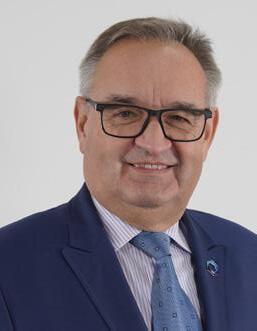
In this issue, ESE warmly welcomes our new President, Wiebke Arlt, our new President-Elect, Mirjam Christ-Crain, and many other new faces on the ESE Committees.
We look forward to working with them all, and thank everyone who is stepping down after working hard for our Society.
In our interview with Wiebke, you can learn about her aims for her presidency, which include further strengthening the voice of the endocrine community, and enhancing diversity within our field. She seeks to involve as many people as possible in ESE’s work – perhaps that could include you? Read more on page 7
Our two science features provide the inspiration for our cover image. They sum up our current understanding of approaches to vitamin D deficiency, and of what constitutes a ‘healthy diet’ (particularly regarding glycaemic control and management of obesity).
In the first, on page 8, Luigi di Filippo and Andrea Giustina consider two recent guideline articles by multidisciplinary expert panels. Their enlightening overview examines the many roles of vitamin D, and how to assess its status, highlighting how the guidelines help to address outstanding controversies.
Then, on page 11, Mary Yannakoulia and Nikolaos Scarmeas share insights from their recent article in New England Journal of Medicine. Several wellestablished diets can be effective in managing type 2 diabetes, obesity and cardiometabolic risk factors. The main challenge may be for patients to adopt them within the constraints of a modern lifestyle.
ESE’s new State of Endocrinology survey is underway. Your input will help make our field stronger and more resilient, by identifying strengths and weaknesses in the research and clinical areas of our discipline. It should take you just 20 minutes to complete, and will have long-lasting benefits. See page 5, and send your contribution by 15 July.
Editor: Marek Bolanowski, Poland
Email: marek.bolanowski@umw.edu.pl
Deputy Editor: Eleni Armeni, Greece/UK
Email: eleniarmeni@hotmail.com
Co-Editor: Wiebke Arlt, UK
Email: ese.president@ese-hormones.org
Editorial Board: Faisal Ahmed, UK
Bjørn Olav Åsvold, Norway
Juan Manuel Jiménez Vacas, UK
Niki Karavitaki, UK
Karim Meeran, UK
Stavroula Paschou, Greece
Victoria Withy, ESE Office
Maria Chiara Zatelli, Italy
Karin Zibar Tomšić, Croatia
Managing Editor: Caroline Brewser
Design: Qube Design Associates
Website: www.ese-hormones.org
©2025 European Society of Endocrinology
Cover Image: ©Shutterstock/Mostovyi Sergii Igorevich
The views expressed by the contributors are not necessarily those of ESE. This document is available on the ESE website, www.ese-hormones.org
The addresses used to email this issue of Endocrine Views were supplied by the members of ESE. If you do not wish to receive further mailings, you can update your mailing preferences in your Member Portal or email info@ese-hormones.org
ESE thanks the following for their support.
Premium Corporate Members: Ascendis Pharma, Esteve, Novo Nordisk, Recordati Rare Diseases
Corporate Members: BridgeBio, Camurus Pharmaceuticals, Inozyme Pharma, Ipsen, Kyowa Kirin, Neurocrine Biosciences, Uni-Pharma
Supporter: Crinetics Pharmaceuticals
Alongside the packed ESE news from the recent exciting Joint Congress in Copenhagen, make sure you read about the legacy event that took place after the Congress. This brought together scientists and policymakers to address the urgent threat from endocrine disruptors, through stronger national and EU action (see page 10).

Editor, Endocrine Views
Endocrinology
Joint Congress celebrates endocrinology across the life course

Colleagues from adult and paediatric endocrinology came together in Copenhagen on 10−13 May to network and spark collaborations at this ground-breaking event, the first Joint Congress of ESE and the European Society for Paediatric Endocrinology (ESPE).
Jérôme Bertherat, who concluded his term as ESE President during the Congress, commented, ‘It is clear that the two communities realise that they have so many things in common. The science was excellent, it was outstanding. It will improve the field of transition, and was a key moment in the management of chronic disease.’
Highlights of the Congress
We asked Cynthia Andoniadou, ESE Congress Committee Chair, and Peter Kühnen, Chair of the ESPE Programme Organising Committee, to share some of their key moments from the Congress.
What did you most enjoy about the Congress?
Peter: I can’t really define my favourite part. However, the lively discussions of clinical and scientific research between participants during and after sessions with excellent speakers were really interesting.
Cynthia: The palpable excitement and broad smiles among delegates, especially coming out of sessions, were wonderful. All of us on the Programme Organising Committee are very proud that the programme content was well-received.
How did it best succeed in its aims?
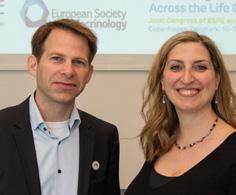
science and clinical research, and visited sessions covering endocrinology across the entire lifespan.
What memories will you take away?
More than 7800 delegates >3400 abstracts submitted from over 120 countries
Cynthia: It provided added value on top of our regular ESPE Meetings and ECE, through uniting the two communities. It gave everyone a lot to think about towards advancing and improving our ‘regular’ practice, for both patient care and scientific discovery.
Peter: Delegates from so many countries, either paediatricians or colleagues from adult medicine, talked to each other, discussed
Peter: The opportunity to meet colleagues from adult medicine and paediatrics at the same Congress, allowing direct discussion of clinical data and science, has been unique. We thank all the delegates, chairs and speakers for their contribution to allow this exchange.
Cynthia: My jaw dropped on seeing the vast number of people in the enormous plenary auditorium, full of delegates: especially when looking into the audience from the stage. Hearing from patients and patient advocates at the Patient Experience Zone reminded me of all the reasons underlying why we pursue our goals in endocrinology research.
Wiebke Arlt becomes ESE President
The Joint Congress in Copenhagen saw Wiebke Arlt step into her new role as ESE President, as Jérôme Bertherat completed his term of office. You can read a full interview with Wiebke on page 7. We thank Jérôme for his unstinting work for ESE during his presidency.


Mirjam Christ-Crain is President-Elect
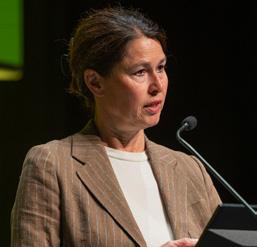
Mirjam Christ-Crain (Switzerland) was appointed as the Society’s President-Elect following the recent AGM, and we welcome her to her new role.
Mirjam was Chair of the ESE Education Committee from 2020 to 2024 and is Professor of Endocrinology, Diabetes and Metabolism at the University of Basel and the University Hospital of Basel, Switzerland.
New Committee Chairs
We welcome Frederic Castinetti (France) as the new Chair of the ESE Clinical Committee, and Marek Ruchała (Poland) as Chair of the ESE Publishing and Communications Committee.
Frederic is Head of the Department of Endocrinology at Aix Marseille University, with an interest in pituitary and adrenal disorders and endocrine tumour syndromes.
Marek is Head of the Department of Endocrinology, Metabolism and Internal Medicine
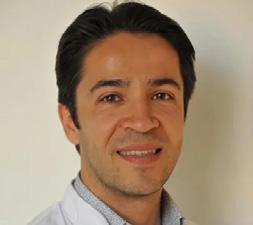
at Poznan University of Medical Sciences, with a broad interest in internal medicine, endocrinology and nuclear medicine.
We thank Martin Fassnacht and Philippe Chanson for their huge contribution to ESE, as they step down from these roles after completing their terms of office.
Following the AGM, we are delighted that 17 ESE Members took up places on ESE Committees EXTERNAL-LINK-ALT . We welcome them all and thank everyone who is stepping down from a committee role.
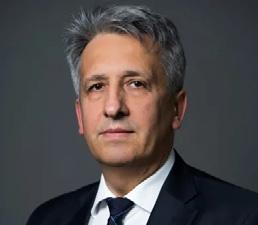
Sadaf Farooqi wins new Joint Award
We congratulate Sadaf Farooqi (UK), who was presented with the new Endocrinology Across the Life Course Award EXTERNAL-LINK-ALT at the Joint Congress in Copenhagen, after her lecture ‘Obesity: from molecules to medicine’. Sadaf was recognised for her fundamental contributions to the discovery and understanding of mechanisms that control human eating behaviour and energy homeostasis. You can see all the recipients of ESE Awards at the Joint Congress on page 12
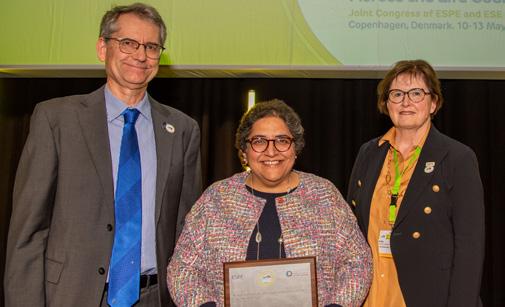
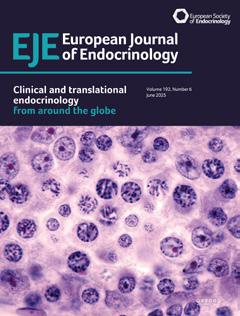
Aggressive pituitary tumours
As featured in Endocrine Views issue 56, an updated ESE Clinical Practical Guideline on the management of aggressive pituitary tumours and pituitary carcinomas has been published in European Journal of Endocrinology Read the guideline EXTERNAL-LINK-ALT
Preparing endocrinology for the future
Our new State of Endocrinology survey needs your input to make our field stronger and more resilient.
The 2019 Mapping Endocrinology in Europe survey has played a vital role in shaping ESE’s advocacy work, but it is now time for an update. So we are asking you to complete an updated survey, which will serve as a ‘fitness test’ for the clinical and the research dimensions of our field.
Clinical endocrinologists are aware of the many demands that they face on a daily basis: an increasing clinical workload alongside a workforce shortage. Meanwhile, scientists see the many opportunities that endocrine research can bring to endocrine health and disease, but securing talent and resources is very competitive.
The new State of Endocrinology survey aims to address how wellprepared we are for the future. It will inform recommendations for how our discipline can cope with the clinical and research challenges and opportunities that we will face. These recommendations will serve our advocacy efforts targeted at healthcare decision makers, mainly at the national level, but also at the European level where possible.
The survey has sections relating to roles within endocrinology. For example, we ask heads of department to tell us more about the structure of their teams, and early-career professionals to provide their training experiences and future expectations. We ask all respondents to assess their working environment, their level of satisfaction with present working conditions, and the professional needs and challenges they see.
‘We are asking you to complete an updated survey, which will serve as a “fitness test” for the clinical and the research dimensions of our field.’

The survey should take on average 20 minutes to complete, depending on your professional profile (you can save it part-way through and return later to finish it).
We thank ESE’s national partner societies for their help in constructing the survey, and for urging their members to respond to it. Each national society will receive a summary report, to inform countryspecific situations.
EYES to meet in Milan
ESE’s early-career members will gather for the 12th Annual Meeting of ESE Young Endocrinologists and Scientists (EYES) in Milan, Italy on 26−28 September 2025.

Abstract submission deadline 6 July 2025
ESE Meeting Grant deadline 25 July 2025
Find out more EXTERNAL-LINK-ALT
This is a unique forum for earlycareer clinicians and scientists, where participants get a chance to present their work and network at an international level.
Why attend?
Enjoy a broad programme spanning diabetes, obesity, pituitary and neuroendocrinology, adrenal and cardiovascular endocrinology, bone metabolism, thyroid disease, endocrine-related cancer, reproduction and infertility.
Hear leading experts including: Guillaume Assié − Innovative strategies for early-career researchers Sadaf Farooqi − Novel insights into obesity management Constantine Stratakis − Omics in pituitary and adrenal disease
Please complete the survey EXTERNAL-LINK-ALT by 15 July at 23.59 CEST

Roberto Vettor − Dysfunctional adipose tissue and obesity complications.
Attend dynamic oral and poster sessions to present your research, exchange ideas with peers and gain feedback from senior faculty.
Win awards for the best oral communications and posters.
Connect with colleagues at a wide range of networking events.
First global campaign is a hit!
The first-ever World Hormone Day campaign on 24 April reached millions of people worldwide.
Thanks to the energy, creativity and commitment of everyone involved in World Hormone Day 2025, the first global campaign to raise awareness of hormone health was a huge success. More than 120 organisations and thousands of individuals from over 40 countries participated through live events, social media videos and posts, hospital pop-ups, TV interviews, news coverage and even an endocrinology escape room!
Materials were translated and shared widely, with World Hormone Day being talked about in at least 25 languages. This helped us reach an estimated audience of more than 136 million people across social media, press and broadcast media around the world.
Raising awareness
The day raised awareness of the importance of hormones and shared the small steps everyone can take to support their own hormone health. It was also an opportunity to encourage policymakers to advocate for health and research policies that promote endocrine wellness. Several national societies reached out to their local politicians, to involve them in their campaign activities.
The #BecauseHormonesMatter booth also celebrated World Hormone Day 2025 during the ESE−ESPE Joint Congress in Copenhagen, Denmark, on 10–13 May. Delegates had the chance to hear more about World Hormone Day, the #BecauseHormonesMatter campaign, and the push to secure greater political support and investment in hormone health and research.
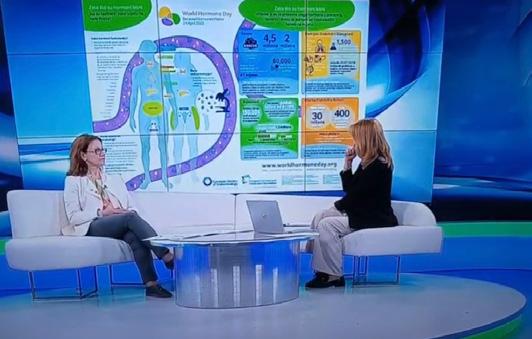
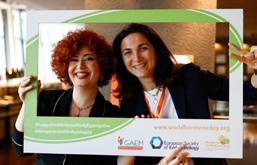
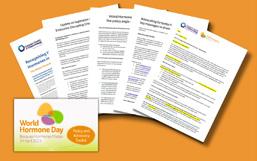
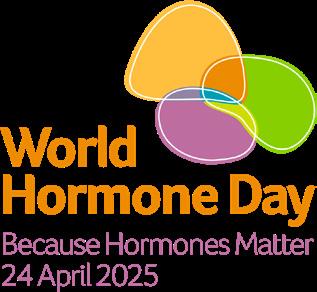
Highlights from World Hormone Day 2025
Keeping hormones in the spotlight
World Hormone Day will return on 24 April 2026, but the work to keep hormones in the spotlight continues. Across Europe and around the world, there are many awareness days and campaigns focused on endocrine health and disease that deserve our support.
By getting involved in these initiatives and continuing to use the hashtag #BecauseHormonesMatter, we can help to amplify the message that hormones matter on every day of the year. Please use the hashtag on any hormone-related days or events you’re involved in, so others can find and share your posts.
You can find key upcoming dates in our online awareness calendar EXTERNAL-LINK-ALT along with a printable version to download and share. The World Hormone Day materials EXTERNAL-LINK-ALT are also still available (including versions without the date) to use year-round, including the Policy Toolkit EXTERNAL-LINK-ALT with resources to help you reach out to policymakers.


Meet your new President
Wiebke Arlt stepped into her new role as ESE President during the Joint Congress in Copenhagen in May. We took the opportunity to talk to her about her vision for ESE over the coming years.
What would you like to achieve as ESE President?
My main aim is to continue to bring the endocrine community together, so that they have a stronger voice to lobby for endocrine science and endocrine care. I am keen to strengthen diversity and to support early-career researchers, scientists and women to engage even more in and for ESE. Finally, I am very keen to ensure that the job description for ESE President is not seen by anybody as difficult to commit to, due to active work and family commitments. It is important to involve as many engaged people as possible in doing ESE’s work − come and join in!
What major challenges can ESE help address?
This is a very broad question. Both healthcare and biomedical science in general are under strain − this definitely also applies to endocrinology. Major health challenges include environmental stressors, such as endocrinedisrupting chemicals and climate change, as well as the obesity crisis. This is why ESE has created two new journals, Environmental Endocrinology and Obesity and Endocrinology, to help solutions to advance faster. We need to ensure we all lobby together and are clear about what we want to achieve in doing so. We need to ensure that early-career trainees see a future in endocrinology and help to build it.
How can research and healthcare inequalities across Europe be minimised? The best approach is to understand what is currently going on, which ESE’s ‘The State of Endocrinology’ initiative is addressing. Then we can work out a path to change things for the better, which will involve educating key stakeholders, and partnerships with other voices in the field.
What relationships must ESE build to raise endocrinology’s profile?
We need to stay united and interact with the public and policymakers for science and healthcare. We also
need to continue relationships with partner societies and forge new ones.
How can ‘manmade’ problems, such as obesity and endocrine disruption, be solved?
ESE has already undertaken excellent lobbying work and great educational efforts, together with our national, specialist and partner societies. During this year’s Joint Congress with ESPE (our paediatric endocrine colleagues), I have clearly seen that they realise this even more acutely, witnessing its impact on children. We need to continue working together, lobbying governments, including the EU, and educating members of the public about this major issue. ESE is also keen to work with the European Association for the Study of Obesity to ensure obesity stays in focus as an endocrine problem with a major impact on many lives and healthcare systems.
How can ESE best support its members? It is important for us to listen to our members and to learn what they need most, in order to best support them – come talk to us!
What part of ECE do you most look forward to each year?
Meeting colleagues! I love to meet old and new friends from many countries and backgrounds.
What changes might endocrinology see in the next 10 years?
I think both endocrine healthcare and endocrine research will see the increasing contribution of machine-learning approaches. I also think that obesity will be a focus for both endocrinologists and diabetologists, leading to collaboration and transformative insights.
If you were just starting out, what new area would you be tempted to investigate? When I started out in research, diabetes and endocrinology
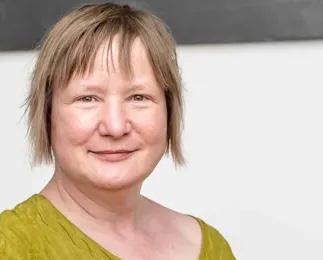
‘My main aim is to continue to bring the endocrine community together, so that they have a stronger voice to lobby for endocrine science and care.’
research were very separate. This has completely changed over the last few decades. Starting out today, I would take a more integrated career path between endocrinology and diabetes and obesity research.
What are we likely to find you doing on a day off?
I will be walking, gardening, hanging out in museums, going to concerts, and spending time with friends and my three cats, George, Clooney and Teddy.
What is your advice for earlycareer endocrinologists?
Be active, have a voice, join us! In wise words often attributed to Abraham Lincoln, ‘The best way to predict your future is to create it.’
What should we ask when you complete your term of office?
Ask me what has surprised me most during my time as ESE President, and what I consider the biggest changes we have achieved together.
How to approach vitamin D deficiency
Luigi di Filippo and Andrea Giustina consider the steps needed to achieve a modern, holistic view of a long-standing problem.
Vitamin D is a fat-soluble steroid hormone. It plays a crucial role in calcium and skeletal homeostasis. Vitamin D deficiency results in reduced intestinal absorption of calcium and phosphate. Severe hypovitaminosis D contributes to diminished mineralisation of newly formed bone tissue and is strongly associated with the risk of developing rickets and osteomalacia.
Hypovitaminosis D is recognised globally as a pervasive health issue, affecting about one-third of the world’s population, with variable prevalence rates ranging from 20−50% in Europe to as high as 80% in Middle Eastern countries. Moreover, vitamin D deficiency can be especially severe in specific patient groups, such as the elderly, obese individuals or those with gastrointestinal malabsorptive conditions, characterised by decreased skin synthesis of cholecalciferol and altered metabolism, distribution or intestinal absorption of this hormone.1
Two guideline articles have recently been published by multidisciplinary panels of recognised international clinical experts in the field of vitamin D: the Consensus Statement on Vitamin D Status Assessment and Supplementation2 and the Endocrine Society Clinical Practice Guideline on Vitamin D for the Prevention of Disease.3 International experts reviewed and discussed controversial topics regarding vitamin D, such as vitamin D metabolism, assessment, actions, and supplementation in healthy populations and in specific clinical conditions.
Examining skeletal and non-skeletal roles of vitamin D
First, skeletal outcomes of vitamin D deficiency were extensively confirmed and presented. Hypovitaminosis D is well known to be associated with a reduction in intestinal calcium absorption, leading to the occurrence of secondary hyperparathyroidism, bone loss and increased risk of fractures, especially in older adults.2 Secondly, beyond the established benefits for bone health, emerging research showing a role for this hormone in various extra-skeletal clinical scenarios was reviewed and assessed.4,5 The vitamin D receptor is ubiquitously present across numerous tissues, potentially allowing this hormone to influence a wide range of cellular processes. Several observational studies have consistently shown that vitamin D, along with its supplementation, may be linked to a variety of diseases, including cancers, obesity, diabetes, and cardiovascular, autoimmune and infectious diseases. In contrast, interventional clinical trials (the so-called ‘mega-trials’) on vitamin D supplementation have led to conflicting results, particularly regarding extra-skeletal endpoints. These studies are limited by their prevalent focus only on the general population, not selected for and often not affected by vitamin D deficiency, and without relevant high-risk features for the specific investigated outcomes. Moreover, doses and regimens of
vitamin D supplementation used in these trials have been highly variable and not based on a treat-to-target scheme. Consequently, these limitations have resulted in inconsistent and non-unanimous evidence regarding many effects of this hormone, even in the general population. However, post hoc analyses of the same studies focused on those presenting with hypovitaminosis D has often led to the opposite results, which are wellpresented and discussed in these recent guideline articles.
The immune system, type 2 diabetes and other diseases
Among the most convincing results regarding the extra-skeletal effects of vitamin D, specific links with the immune system and development of type 2 diabetes mellitus were particularly assessed.
Three major trials showed modest diabetes risk reduction with vitamin D supplementation, and these benefits were seen primarily in those with prediabetes.6 However, the optimal dose to be used in this setting remains unclear, since subjects in these trials were mainly treated with higher doses of vitamin D than those recommended in the general population.
Regarding the role of vitamin D in immunity, the VITAL study showed that its supplementation decreased the risk of autoimmune diseases, especially rheumatoid arthritis and polymyalgia rheumatica,7 supporting our recent data on the role of vitamin D deficiency in acute COVID-19 and long COVID.8−10
Cardiovascular events and mortality may be positively affected as well. The positive but small effect of vitamin D on mortality was confirmed by a recent umbrella review of observational, randomised and Mendelian randomisation studies.11
Assessing vitamin D status
Serum 25-hydroxyvitamin D (25OHD) concentration is the most accepted biochemical marker of vitamin D status. However, assay methodology and
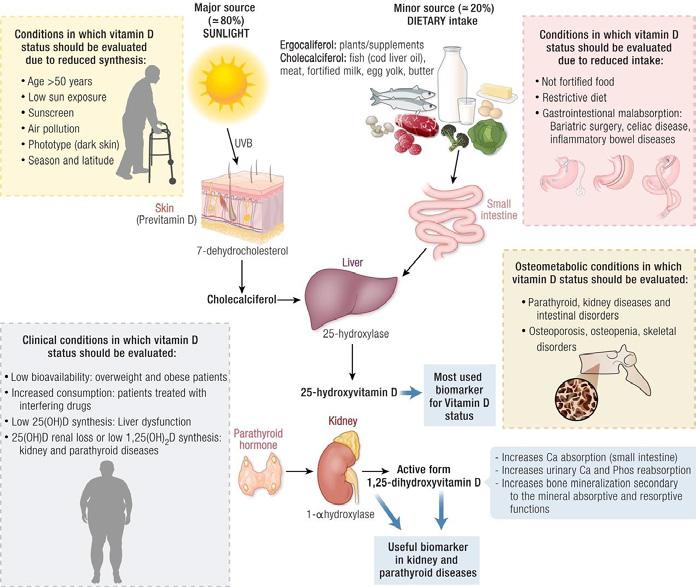
standardisation, as well as desirable levels, which may vary according to the underlying conditions, still represent major issues in this field.2 It is recommended that optimal 25OHD levels are in the range of 20−50ng/ml in the general population, but in specific groups of patients (e.g. those with osteoporosis), the threshold level may be higher (>30ng/ml).
Regarding assessment of vitamin D status, in general populations with low risk of vitamin D deficiency, routine screening of 25OHD concentrations may not be cost-effective. Therefore, the decision to assess vitamin D status should be based on clinical indication with a risk stratification approach.2
Vitamin D supplementation with daily supplement regimens seems to be the most effective and beneficial strategy to improve vitamin D status.2 However, supplementation with longer intervals (e.g. weekly or monthly) at higher doses has been proposed to overcome low compliance that is often present with daily schedules. Oral cholecalciferol (vitamin D3) is considered the preferred form of vitamin D for supplementation, while use of other forms of vitamin D, including calcifediol, calcitriol and alfacalcidol, as well as parenteral cholecalciferol administration, should be considered in specific conditions.2
In conclusion
Our expanding knowledge of the role of vitamin D in health and disease, as well as its widespread deficiency, has prompted different organisations and expert groups to undertake a thorough evaluation and assessment of the existing literature, in order to issue recommendations on its assay and use, either in the general population3 or in specific diseases.2
This effort represents an important contribution to the objective of overcoming at least some of the controversies existing in the field, in
clarifying that vitamin D is not a ‘magic weapon’ for every condition, but is a pleiotropic hormone, the deficiency of which should be assessed and replaced as clinically indicated.
The advent of national or international registries for vitamin D treatment, such as the one recently implemented in IRCCS San Raffaele Hospital in Milan, will probably allow us to overcome the many limitations of megatrials and give clinical evidence for the future further refinement of current guidelines on vitamin D.5
Luigi di Filippo and Andrea Giustina
Institute of Endocrine and Metabolic Sciences, Università Vita-Salute San Raffaele, IRCCS Ospedale San Raffaele, Milan, Italy
REFERENCES
1. Bilezikian et al. 2021 Reviews in Endocrine & Metabolic Disorders https://doi.org/10.1007/s11154-021-09693-7
2. Giustina et al. 2024 Endocrine Reviews https://doi.org/10.1210/endrev/bnae009
3. Demay et al. 2025 Journal of Clinical Endocrinology & Metabolism https://doi.org/10.1210/clinem/dgae290 (corrected at https://doi.org/10.1210/clinem/dgae854).
4. Bouillon et al. 2019 Endocrine Reviews https://doi.org/10.1210/er.2018-00126
5. Giustina et al. 2024 Nature Reviews Endocrinology https://doi.org/10.1038/s41574-023-00942-0
6. Pittas et al. 2023 Annals of Internal Medicine https://doi.org/10.7326/M22-3018
7. Hahn et al. 2022 BMJ https://doi.org/10.1136/bmj-2021-066452
8. di Filippo et al. 2023 Endocrine https://doi.org/10.1007/s12020-023-03331-9
9. di Filippo et al. 2022 Endocrine https://doi.org/10.1007/s12020-022-03135-3
10. di Filippo et al. 2023 Journal of Clinical Endocrinology & Metabolism https://doi.org/10.1210/clinem/dgad207
11. Liu et al. 2022 Advances in Nutrition https://doi.org/10.1093/advances/nmab142
EndoCompass launched in Copenhagen
One of the highlights of the ESPE−ESE Joint Congress in Copenhagen was the much-anticipated launch of the EndoCompass Research Roadmap.

Designed to strengthen co-ordination and visibility in the field, the Roadmap spans eight endocrine specialties and five cross-cutting themes. It is a valuable resource for the endocrine community to use, reference and share – ensuring hormone health gets the attention it deserves.
Two dedicated sessions at the Congress focused on the report:
• A symposium on key findings, particularly cross-cutting areas of endocrine research, such as artificial intelligence, laboratory medicine and early careers. This was led by EndoCompass Co-Chairs Martin Fassnacht and Martine Cools, with speakers including Guillaume Assié, Annemieke Heijboer, Jonathan Mertens and Rade Vukovic.
• A special session on endocrine science’s importance for society and the need for greater investment. Manuel Heitor, who chaired the Independent Expert Group on the Interim Evaluation of Horizon Europe, gave a keynote speech on scientific activism for ‘Choose Europe’ – a campaign to make Europe an attractive place for researchers. He commented that ‘EndoCompass is a great example of a scientific community leading by example and showing how collaboration can make this a reality.’
You can increase the Roadmap’s impact by sharing and citing its reports, which will be available shortly in European Journal of Endocrinology EXTERNAL-LINK-ALT
Watch all the speaker presentations online EXTERNAL-LINK-ALT
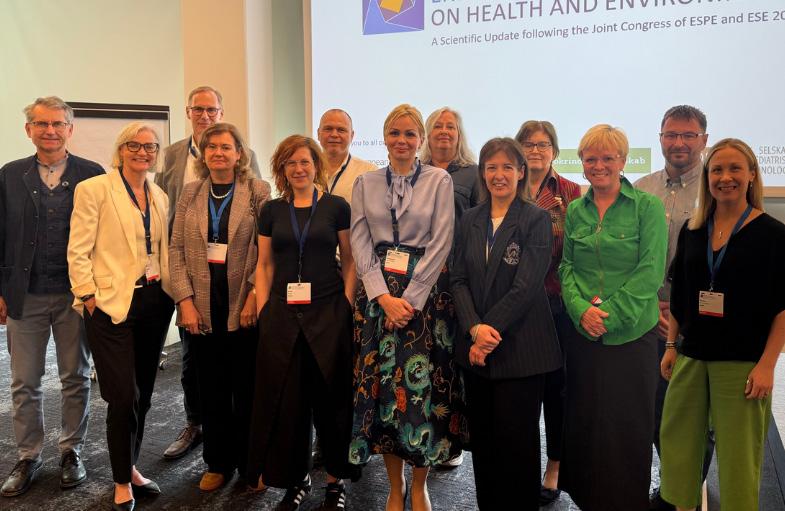
Calling for control of EDCs
A legacy event following the Joint Congress in Copenhagen took the opportunity to highlight the urgent need for better regulation of endocrine-disrupting chemicals (EDCs).
On 14 May 2025, the day after the Joint Congress closed, ESE and ESPE (the European Society for Paediatric Endocrinology) came together with the Danish endocrine community to host the event, entitled Minimising the impact of endocrine-disrupting chemicals on health and environment EXTERNAL-LINK-ALT
About 200 people attended online and 70 in person. The legacy event brought together European scientists, policymakers and others to address the urgent health and environmental threat from EDCs, with the aim of achieving stronger national and EU action on endocrine disruptors. At the time of the event, Denmark was preparing to take over the Presidency of the EU Council (from 1 July), so it was a valuable opportunity to strengthen the dialogue between science and policy.
Jérôme Bertherat, outgoing ESE President, commented, ‘We need to change the conversation around endocrine disruptors in Europe and ensure the necessary research and policy measures are implemented now.’ Anita Hokken-Koelega, ESPE President, added, ‘Children are especially vulnerable to the effects of exposure to endocrine disruptors. Policymakers across Europe must uphold their responsibility to provide a toxic-free environment for them to grow and develop.’
The event included a focus on key research that had been presented at the Joint Congress, as well as future priorities from the EndoCompass Research Roadmap EXTERNAL-LINK-ALT
‘The legacy event brought together European scientists, policymakers and others to address the urgent health and environmental threat from EDCs.’
A few of the highlights
• Insights from Members of the Danish and European Parliaments on the current policy debate
• A tandem talk on fertility and EDCs from both adult and paediatric perspectives
• A focus on new approach methodologies and their role in better and faster EDC assessment
• A testimonial on how perfluoroalkyl and polyfluoroalkyl substances (PFAS) affect local communities in Denmark.
Diets for glycaemic control and obesity
Humans choose their diets based on socioeconomic, cultural and individual factors. In turn, these diets provide nutrients to the human body and have desirable or undesirable consequences. Although diets are highly individualised and nearly everyone follows their own diet, they can still be grouped into categories. The most widely recognised types of diets will be briefly presented here, with an emphasis on their effects on glycaemic control and obesity.
The
Mediterranean diet
This diet has gained worldwide recognition. It is dominated by plant foods (fruits, vegetables, cereals (processed as little as possible), pulses, nuts and seeds) and contains moderate amounts of dairy products, low-tomoderate amounts of fish and poultry, low amounts of red meat, and wine in moderation. Most importantly, olive oil is the main added fat.
Originally, it was promoted as a model for preventing coronary heart disease, but a robust body of evidence denotes that adherence to this diet is also beneficially connected with overall mortality, neurodegenerative diseases, type 2 diabetes and some types of cancer. Despite the relatively high contribution of lipids to the total energy intake, it has beneficial effects on blood glucose levels and body weight. This diet raises no concerns, apart from the potential limited availability of some food items outside the Mediterranean region.
Vegetarian diets
These exclude meat and, to varying extents, other animal products. The vegan diet is a more restrictive type (absence of all animal-derived products), whereas a flexitarian diet refers to a range of dietary patterns that include some animal products.
These diets may be adopted for reasons related to life philosophy, ecology or health, and they are linked to a reduced risk of type 2 diabetes, cardiovascular disease and, again, some types of cancer. Their role in weight management remains debated, although they can be recommended for achieving negative energy balance. Appropriately planned vegetarian/ vegan diets can be nutritionally adequate, but clinicians need to keep in mind that the more restrictive the diet, the higher the risk of various nutrient deficiencies.
Low-fat diets
Here, lipids contribute <30% of the total energy intake. Low-fat diets have been shown to induce weight loss compared with a typical diet, but they may be less effective than low-carbohydrate or other dietary approaches. They have a beneficial effect on type 2 diabetes and all-cause mortality, while the type of fat consumed may also play a significant role. Adherence to these diets can be challenging, as one has to avoid many animal products and to eliminate oils and fats.
Low-carbohydrate diets
These diets contain 50–150g of carbohydrates per day. Several popular diets fall into this category, including the Atkins, Zone and South Beach diets. Ketogenic diets can be any diet that contains <50g of carbohydrates per day, an amount that induces the production of ketone bodies for most individuals. Low glycaemic diets can also be considered as low-carbohydrate diets, though they do not restrict carbohydrates per se but, rather, foods with a high glycaemic index.
Adoption of a low-carbohydrate diet produces, to a greater or a lesser extent, metabolic changes similar to those seen during a starving state, i.e. changes in plasma levels of free fatty acids, insulin and glucose. Overall, low-carbohydrate diets may be a reasonable option for achieving glycaemic control in patients with type 2 diabetes. Despite their initial advantage, they result in weight loss that is equivalent to that of diets with higher

carbohydrate content. Several concerns have been discussed about these diets, mainly related to their unfavourable effects on blood lipid levels.
Intermittent fasting
During recent years, this has been very popular. Fasting, or very low calorie intake, days are followed by days of unrestricted food intake, according to several schemes. Alternatively, eating takes place only for a specific period during the day (usually for 8−10 hours; time-restricted eating). A metabolic switch in fuel source from glucose to fatty acids and ketone bodies is expected to take place.
So far, short-term studies in humans have indicated beneficial effects in glucose regulation and type 2 diabetes, body composition and obesity, but their long-term effects are comparable to those achieved through continuous energy restriction.
In conclusion
Several well-established diets can be proven as effective tools for the management of type 2 diabetes, obesity and cardiometabolic risk factors. A clinician’s decision regarding the most appropriate diet needs to be personalised, considering medical history as well as a series of diet-related issues.
All diets – those presented here and many others – have been developed or promoted in different cultural, research or societal frameworks. The extent to which they can be effectively transferred and adapted to meet specific individual needs remains uncertain. In addition, humans and their diets form a complex ecosystem: a decrease in one particular nutrient or food group is accompanied by a parallel increase in another nutrient or food, desirable or not.
For most people, the safest health recommendation is a plant-based diet, of moderate lipid content, with low-to-moderate amounts of poultry and seafood, and low quantities of red meat and sugar products. The next step is to initiate counselling to facilitate the adoption of the healthy diet within the constraints of a modern lifestyle. And this latter part may be quite challenging.
Mary Yannakoulia Department of Nutrition and Dietetics, Harokopio University, Athens, Greece
Nikolaos Scarmeas
First Department of Neurology, Aiginintio Hospital, National and Kapodistrian University of Athens, Greece, and Department of Neurology, Columbia University, New York, NY, USA
FURTHER READING
− Yannakoulia & Scarmeas 2024 New England Journal of Medicine https://doi.org/10.1056/NEJMra2211889
− Dinu et al. 2020 Advances in Nutrition https://doi.org/10.1093/advances/nmaa006
− Dybvik et al. 2023 European Journal of Nutrition https://doi.org/10.1007/s00394-022-02942-8
− Khalafi et al. 2025 Obesity Reviews https://doi.org/10.1111/obr.13855
− Kirkpatrick et al. 2019 Journal of Clinical Lipidology https://doi.org/10.1016/j.jacl.2019.08.003
− Schutz et al. 2021 Obesity Reviews https://doi.org/10.1111/obr.13195
− Willett et al. 2019 Lancet https://doi.org/10.1016/s0140-6736(18)31788-4
Celebrating success in 2025
Honorary Membership
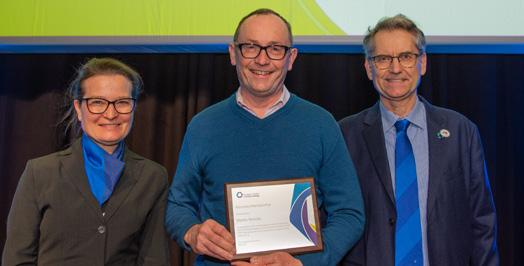
Martin Reincke (Germany, pictured with ESE Secretary Maria Chiara Zatelli, left, and outgoing ESE President Jérôme Bertherat, right) was awarded Honorary Membership of ESE, in recognition of his outstanding service to the Society as President (2019−2023) and as an Executive Committee member (2009−2013).
Award Lecturers and other ESE Award recipients

Thierry Brue (France)
Geoffrey Harris Award
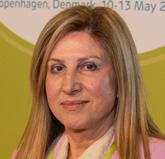
Eugenia Vlachou (Greece)
European Endocrine Nurse Award
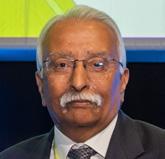
Krishna Chatterjee (UK)
European Hormone Medal

Massimo Terzolo (Italy) Clinical Endocrinology Journal Foundation Award

Sadaf Farooqi (UK)
Endocrinology Across the Life Course Award

Ana Djordjevic (Serbia)
Jens Sandahl Christiansen Award (Basic Science)
Special Recognition Awards


Cesar Boguszewski (left, Brazil) and Djuro Macut (Serbia) received Special Recognition Awards. Cesar was recognised for strengthening relationships between ESE, Brazil and South America through valuable collaboration between the Brazilian Society of Endocrinology and Metabolism and ESE. Djuro was recognised for his long dedication to ESE, as the Executive Committee member responsible for ECAS (2016−2020) and as Treasurer (2020−2024).

Kashyap Patel (UK)
European Journal of Endocrinology Award
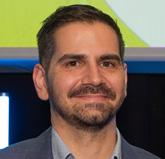
Alessandro Prete (UK)
Jens Sandahl Christiansen Award (Clinical Science)
You can read interviews with our Award Lecturers in the ECE Blog EXTERNAL-LINK-ALT
Young Investigator Award winners
The 2025 recipients are Merisa Abusdal (Norway), Anna Angelousi (Greece), Muhammad Fahad Arshad (UK), Valeria Citterio (Italy), Álvaro Flores-Martínez (Spain), Lucía Iglesias García (Argentina), James Kaufman-Cook (UK), Tinatin Kutchukidze (Georgia), Alessandra Mangone (Italy), Mikkel Thor Olsen (Denmark), Cem Sulu (Turkey) and Zhuolun Sun (Germany).
Poster Award winners
The 2025 winners were Mohamed Abubaker (UK), Merisa Abusdal (Norway), Corin Badiu (Romania), Felix Chelslin (Sweden), Nathalie Erpelding (USA), Isabel Viola Frielitz-Wagner (Germany), Laura Lucaccioni (Italy), Malene Asp Bock Mejdahl (Denmark), Sema Okutan (Denmark), Luigi Picaro (UK), Philippa Prentice (UK), Mercedes Rivera Cuello (Spain), Patrice Rodien (France), Carin Skogastierna (Sweden), Lorenzo Tucci (Italy) and Yi Wang (China).
People’s Choice Award winners
Awards for the best clinical, basic and translational abstracts as chosen by delegates and the Joint Programme Organising Committee were presented to Anna Matveeva (Switzerland), María Isabel Pozo Relaño (Spain) and Mert Uçar (Turkey).

